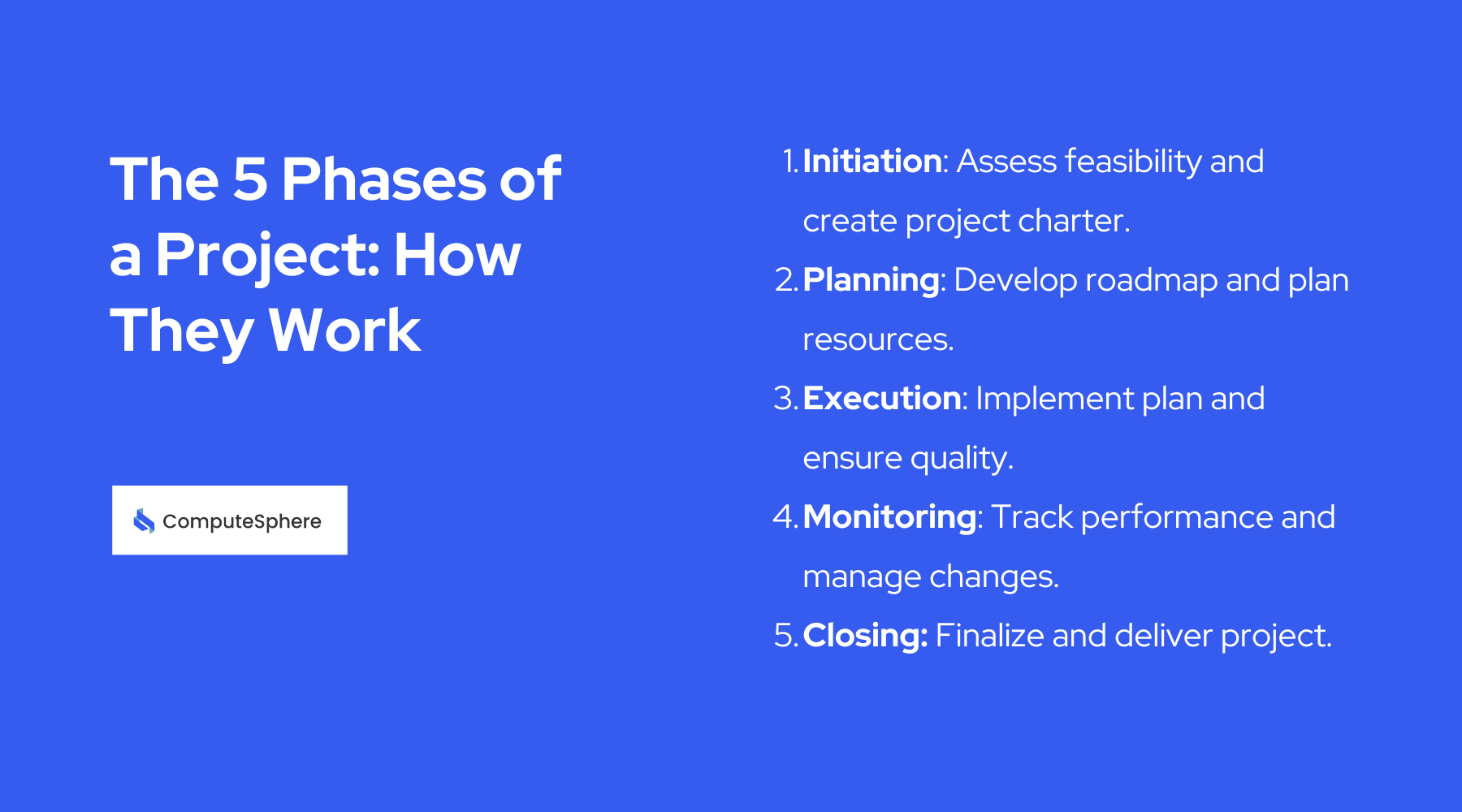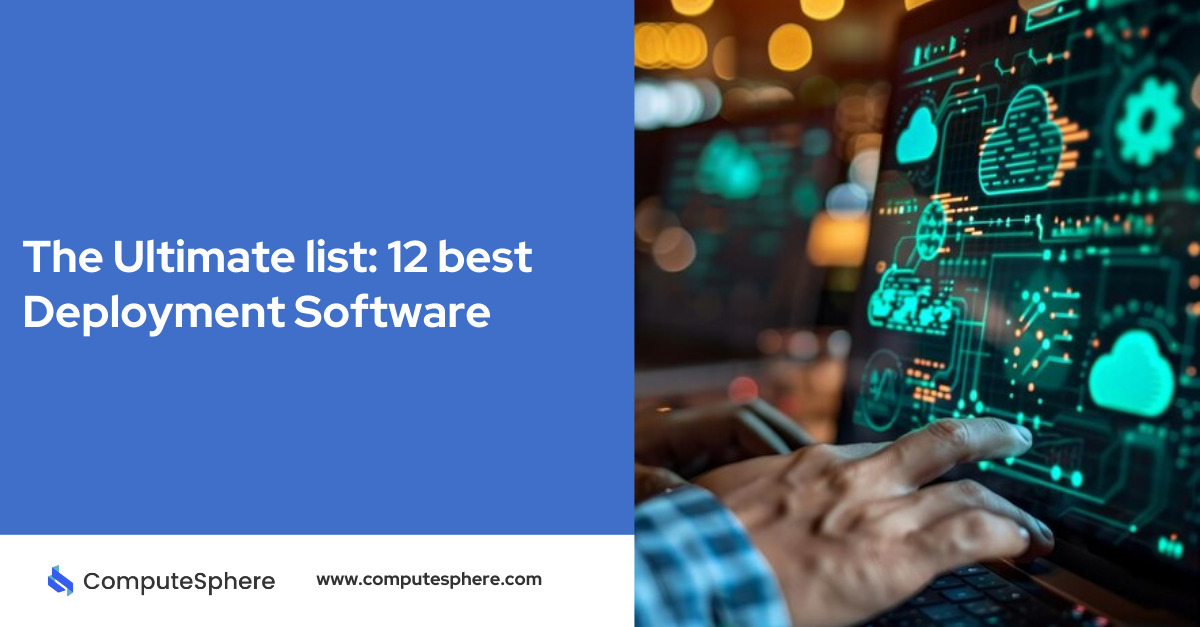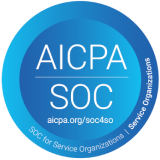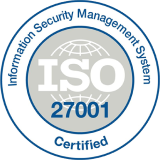What Are the 5 Phases of a Project and How Do They Work?

Did you know that around 70% of projects fail due to a lack of proper planning and execution? This statistic underscores the crucial importance of understanding the distinct phases of a project. Effective project management is not just about getting tasks done; it's about knowing when and how to execute each step of the process.
The five phases of a project – Initiation, Planning, Execution, Monitoring and Controlling, and Closing – provide a structured framework that can significantly improve the chances of project success. Here is the detail of these phases, with insights into their purposes, key activities, tools, and outputs, to help you manage your projects more efficiently and effectively.
What Are the 5 Phases of a Project?

Phase 1: Project Initiation
Project initiation is the first and perhaps the most important phase of a project. During this phase, the project’s value and feasibility are measured. It is the foundation upon which the entire project is built. Without a solid initiation phase, the project is likely to encounter numerous challenges and may even fail.
Key Activities
One of the primary activities during the initiation phase is developing a project charter. This document formally authorizes the project, outlining its objectives, scope, and stakeholders. It acts as a reference point throughout the project’s lifecycle.
Another important activity is identifying stakeholders. Knowing who will be impacted by the project and who has a vested interest in its outcome is essential for effective communication and project support.
Finally, defining the initial scope and objectives sets the stage for the planning phase. This involves outlining what the project aims to achieve and any constraints that may affect its progress.
Output
The key outputs of the initiation phase are the project charter and the stakeholder register. These documents provide a clear understanding of the project’s purpose, scope, and key players involved.
Phase 2: Project Planning
The planning phase is where the roadmap for the project is created. A well-structured plan is important for guiding the team and stakeholders through the project. This phase involves detailed planning to ensure all aspects of the project are considered.
Key Activities
Defining the project scope in detail is one of the primary activities in this phase. This involves breaking down the project into manageable tasks and defining what is and isn’t included in the project.
Developing a comprehensive project management plan is another critical activity. This plan outlines how the project will be executed, monitored, and controlled. It includes aspects such as timelines, budgets, resource allocation, and communication strategies.
Creating a Work Breakdown Structure (WBS) helps in organizing the project’s tasks. It breaks down the project into smaller, more manageable components, making it easier to assign tasks and track progress.
Estimating resources and time is essential to ensure the project stays on track and within budget. This involves calculating the resources needed for each task and the time required to complete them.
Risk management planning is also vital. Identifying potential risks and developing strategies to mitigate them can save the project from unforeseen challenges.
Tools and Techniques
Various tools and techniques can be used during the planning phase. Gantt charts help in visualizing the project schedule, while the Critical Path Method (CPM) aids in identifying the most important tasks that could impact the project timeline. Risk assessment matrices help in evaluating potential risks and their impact on the project.
Output
The primary outputs of the planning phase are the project management plan, the Work Breakdown Structure (WBS), and the risk management plan.
Phase 3: Project Execution
The execution phase is where the project plan is put into action. This phase involves coordinating people and resources to carry out the project tasks. The project manager plays a crucial role in this phase, ensuring that everything goes according to plan.
Key Activities
Assigning tasks and responsibilities is the first step in the execution phase. Ensuring that everyone knows their roles and responsibilities helps in maintaining order and efficiency.
Directing and managing project work involves overseeing the day-to-day activities and ensuring that tasks are completed on time and within budget. This requires effective communication and coordination among team members.
Ensuring quality assurance is essential to meet the project’s standards and requirements. This involves regular inspections and quality checks to ensure the deliverables meet the expected quality.
Regular team meetings and updates are important for keeping everyone on the same page. These meetings provide an opportunity to discuss progress, address any issues, and make necessary adjustments to the plan.
Tools and Techniques
Various tools and techniques can aid in the execution phase. Project management software such as Trello and Asana helps in tracking tasks and progress. Communication tools like Slack and Microsoft Teams facilitate effective communication among team members.
Output
The main outputs of the execution phase are the deliverables as per the project plan and performance reports. These documents provide a clear record of what has been achieved and any challenges faced during execution.
Phase 4: Project Monitoring and Controlling
Monitoring and controlling is an ongoing process that ensures the project stays on track. This phase involves tracking the project’s performance and making necessary adjustments to keep it aligned with the plan.
Key Activities
Tracking project performance is the primary activity in this phase. This involves measuring the project’s progress against the plan and identifying any deviations.
Managing changes to the project scope, schedule, and costs is essential to avoid scope creep and ensure the project stays within its boundaries. This involves evaluating change requests and making necessary adjustments.
Quality control and risk management are ongoing activities that ensure the project meets its standards and any potential risks are addressed promptly.
Regular status meetings and progress updates help in keeping everyone informed about the project’s status and any changes made.
Tools and Techniques
Key Performance Indicators (KPIs) are used to measure the project’s performance. Earned Value Management (EVM) helps in assessing the project’s progress and performance. Change management processes ensure any changes are evaluated and approved before implementation.
Output
The main outputs of the monitoring and controlling phase are performance reports and change request documentation. These documents provide a clear record of the project’s status and any changes made.
Phase 5: Project Closing
Project closing is the final phase of a project. This phase involves finalizing all activities and formally closing the project. It ensures that all deliverables are completed, and the project is formally handed over to the client or stakeholders.
Key Activities
Delivering final deliverables is the first step in the closing phase. This involves ensuring that all project outputs are completed and meet the expected quality.
Obtaining formal acceptance from stakeholders is essential to ensure that the project meets their expectations. This involves getting their sign-off on the final deliverables.
Conducting a post-project evaluation and lessons learned helps in identifying what went well and what could be improved in future projects. This involves reviewing the project’s performance and documenting any lessons learned.
Output
The primary outputs of the closing phase are the final project report, lessons learned documentation and formal project closure. These documents provide a clear record of the project’s completion and any lessons learned for future reference.
Conclusion
Understanding the five phases of a project is important for effective project management. Each phase has its own set of processes and deliverables that collectively ensure the project’s success. By following these phases, you can manage your projects more effectively and increase the likelihood of their success. So, the next time you start on a project, remember to follow these phases to ensure a smooth and successful project journey.
Contents
Built for Builders. Priced for Startups.
Tired of unpredictable cloud bills? ComputeSphere offers modular, fixed-cost cloud hosting that grows with your startup—no DevOps headaches, no surprises.
Get StartedShare this article
Browse Some Related Blogs
Relevant and related contents you can read









